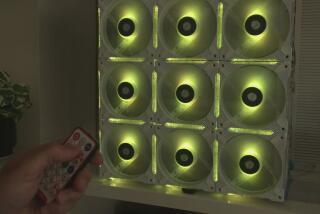Home Improvement : Houseplants Can Help Clear the Air
QUESTION: I have an energy-efficient house. During the colder weather, it gets stuffy and I don’t feel as good as I usually do. Is there any energy-efficient method to improve the air quality without investing a lot in special systems?
ANSWER: The most energy-efficient and inexpensive method to improve the air quality in your home is to reduce the amount of pollutants you put into the air. There has also been some recent research done which shows that certain varieties of common houseplants can help purify indoor air.
Many of the chemicals from cleaners, waxes, and materials in your home may build up and actually make you feel ill, irritable and depressed. When you are doing polluting activities like cooking, cleaning or painting, operate an exhaust vent fan. Close the doors to that room and crack open a window just a little to reduce the loss of heated air from the rest of your home.
Replace synthetic household cleaners and materials in your home with natural ones. For example, polyester curtains or vinyl shades can give off fumes when heated by the sun. Cotton or wood is better. If you dry-clean curtains, hang them outdoors first before rehanging them.
You can use a water/vinegar solution to clean greasy film from a vinyl floor. Then use club soda to polish the floor. You can clean tar off a floor by first scraping off the excess with a knife. Then rub it vigorously with a dry cloth and butter or margarine.
Instead of using spray cleaners and polishes, you can remove water marks from furniture naturally. Mix a small amount of wood ash with cooking oil and apply with a soft cloth.
The National Aeronautics and Space Administration (NASA) has done research using houseplants to remove such harmful chemicals as formaldehyde and benzene from indoor air. Certain common houseplants, such as the spider plant, have been found to be particularly effective for purifying the air naturally.
In addition to removing indoor pollution and producing oxygen, indoor plants add needed moisture in the winter. You should place the plants in areas where air circulates, perhaps a hallway or near a return register.
There are companies that produce completely natural cleaners, waxes, adhesives, paints and even shoe polishes. Some use only coconut oil as a base, no petrochemicals, and the products are totally biodegradable. They are available through health food outlets and by mail order.
You can write to me for Utility Bills Update No. 382, which includes “low-tox” cleaning tips, a list of 10 house plants useful for purifying air and a list of manufacturers of natural cleaners and products. Please include $1 and a self-addressed business-sized envelope. Send your requests to James Dulley, c/o The Los Angeles Times, 6906 Royalgreen Drive, Cincinnati, Ohio 45244.
Lower Setting Is Best on Home Thermostat
Q: I recently installed a computerized setback thermostat that allows for four different temperature settings at four different times of the day. Is it possible to set it too low and waste energy heating it up again?
A: With most furnaces--gas, oil or electric--the lower you set your thermostat, the better. Heat loss is a function of the temperature difference between indoor and outdoor air. If the temperature difference is less, then the heat loss is less.
Even with a heat pump thermostat, setting it back too much at night may not yield savings as great as you anticipate. In the morning, when the outdoor temperature is lowest, the heat pump may not be able to heat your house quickly enough. Then the expensive back-up resistance heater may kick on.






